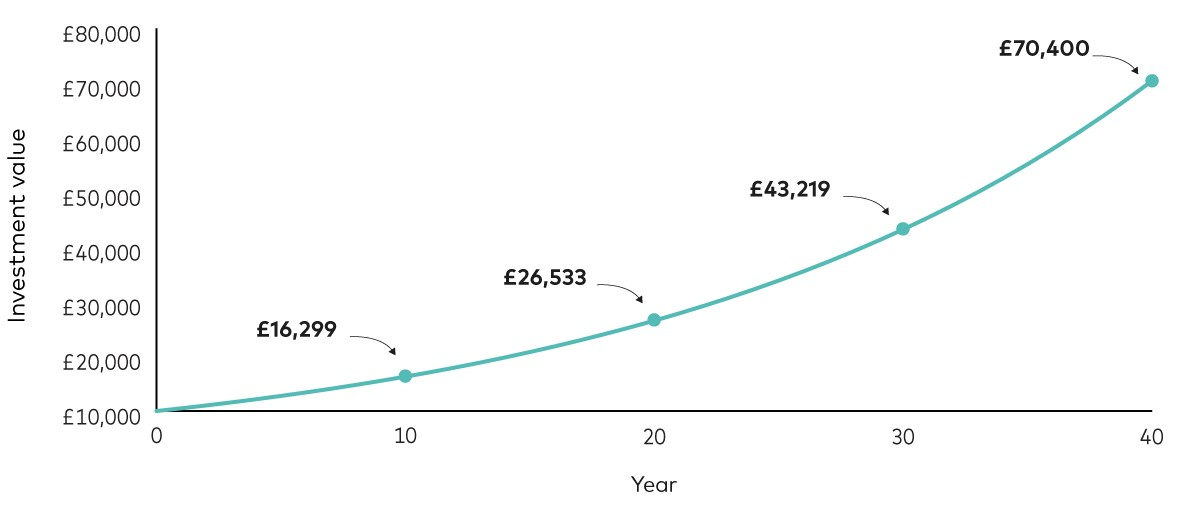
Where to invest a lump sum of money
Knowing where to invest a lump sum isn’t always easy. From boosting your emergency savings to investing in ISAs and pensions, we explore four options.
If you’ve received a lump sum of money – perhaps a Christmas bonus or financial gift – you might be wondering what to do with it.
Splashing the cash is one option, but putting the money aside for your future could prove a lot more rewarding in the long run. The key question is, where?
There are several options to choose from when investing a lump sum and it isn’t always easy to know which is best. To help you get started, we’ve summarised four options to consider.
Emergency savings pot
First and foremost, it’s a good idea to check whether you have a sufficient emergency savings pot. That’s the amount of money you would need to cover unexpected bills, such as your boiler or car breaking down, or a period of unemployment.
For one-off expenses, one rule of thumb is to keep the greater of £2,000 or half a month’s expenses in a bank account. When it comes to an income shock, you’ll want more than just a few weeks’ savings set aside. We generally suggest holding 3-6 months’ worth of expenses in an accessible account. If you don’t have this already, consider using your lump sum to start or top up your emergency fund.
Diversified investment portfolio
For savings over and above your emergency fund, it’s worth considering investing in the stock market.
If you’re able to commit your money for at least five years and are willing to accept the risk that comes with investing, shares have historically offered higher returns than cash or bonds1 over the long term, albeit with greater volatility (or swings in prices). Although investments go down as well as up and you may get back less than you invested, history shows that patient investors tend to be rewarded for this extra risk.
One way to reduce the level of risk in your portfolio is to spread your money across different assets, such as shares and bonds. Different asset classes tend to perform differently in a range of economic conditions, which can help to soften the impact of losses in one part of your portfolio. You can diversify your investments further by investing in different sectors and regions.
Ensuring you have a balanced portfolio isn’t always easy to do on your own. If you want a helping hand, we offer a managed service for those investing via our individual savings account (ISA) or personal pension. We’ll select a balanced portfolio of investments for you, based on your attitude to risk.
If you’re happy to build your portfolio yourself, our all-in-one multi-asset funds, such as our LifeStrategy funds, are already diversified across global shares and bonds.
Tax-efficient ISA
To really make the most of your lump sum, you need to make sure you’re not paying more tax than necessary. That’s why it’s so important to invest through an ISA.
An ISA is a tax-efficient ‘wrapper’ that lets your money grow free from the income tax you might pay on the dividends or interest you receive, as well as the capital gains tax (CGT) that could be applied on any profits that you make. Under current rules, you can invest up to £20,000 in ISAs each tax year.
Personal pension
If you don’t need your lump sum any time soon, investing it in a pension could give your retirement savings a much-needed boost.
Your retirement might be decades away, but it’s never too early to start investing. You could spend two or even three decades in retirement, so the more you can contribute to your pension now, the better. Investing early on will let you harness the full power of compounding – when you earn returns on the money you invest as well as on the returns themselves.
As the chart below shows, compounding can be particularly powerful over long periods. In our hypothetical example, a lump sum investment of £10,000 grows to £16,289 after 10 years, assuming annual returns of 5%. Over 20 years, the investment increases to £26,533, and after 40 years its value balloons to £70,400.
It pays to start early

Notes: This hypothetical scenario is for illustrative purposes only and doesn’t represent a particular investment or its expected returns. It assumes annual returns of 5%. Balances reflect the value at the end of each period. The chart doesn’t account for taxes and management or platform fees.
When you make a personal pension contribution, you’ll also get an additional 20% in pension tax relief from the government. For every £80 you contribute to your pension, you’ll get a top-up of £20. If you’re a higher-rate or additional-rate taxpayer, you can claim back an additional £20 or £25, respectively, via your self-assessment tax return. This can help to supercharge how much money you have at retirement, and really make the most of that unexpected lump sum.
1 Bonds are a type of loan issued by governments or companies, which typically pay a fixed amount of interest and return the capital at the end of the term.
Investment risk information
The value of investments, and the income from them, may fall or rise and investors may get back less than they invested.
The eligibility to invest in either ISA or Junior ISA depends on individual circumstances and all tax rules may change in future.
Eligibility to invest in a Vanguard Personal Pension depends on your individual circumstances. Please be aware that pension and tax rules may change in the future and the value of investments can go down as well as up, so you might get back less than you invested. You cannot usually access your pension savings or make any withdrawals until the age of 55, rising to the age of 57 in 2028.
Any tax reliefs referred to are those available under current legislation, which may change, and their availability and value will depend on your individual circumstances. If you have questions relating to your specific tax situation, please contact your tax adviser.
If you are not sure of the suitability or appropriateness of any investment, product or service you should consult an authorised financial adviser. Please note this may incur a charge.
For further information on risks please see the “Risk Factors” section of the prospectus on our website.
Important information
Vanguard only gives information on products and services and does not give investment advice based on individual circumstances. If you have any questions related to your investment decision or the suitability or appropriateness for you of the product[s] described, please contact your financial adviser.
For further information on the fund's investment policies and risks, please refer to the prospectus of the UCITS and to the KIID before making any final investment decisions. The KIID for this fund is available, alongside the prospectus via Vanguard’s website.
This is designed for use by, and is directed only at persons resident in the UK.
The information contained herein is not to be regarded as an offer to buy or sell or the solicitation of any offer to buy or sell securities in any jurisdiction where such an offer or solicitation is against the law, or to anyone to whom it is unlawful to make such an offer or solicitation, or if the person making the offer or solicitation is not qualified to do so. The information is general in nature and does not constitute legal, tax, or investment advice.
Potential investors are urged to consult their professional advisers on the implications of making an investment in, holding or disposing of shares and /or units of, and the receipt of distribution from any investment.
Vanguard will manage your investments in the Managed SIPP on your behalf. You will not be able to place trades on your own account.
Vanguard will manage your investments in the Managed ISA on your behalf. You will not be able to place trades on your own account.
The Authorised Corporate Director for Vanguard LifeStrategy Funds ICVC is Vanguard Investments UK, Limited. Vanguard Asset Management, Limited is a distributor of Vanguard LifeStrategy Funds ICVC.
Issued by Vanguard Asset Management Limited, which is authorised and regulated in the UK by the Financial Conduct Authority.
© 2024 Vanguard Asset Management Limited. All rights reserved.
4110691

